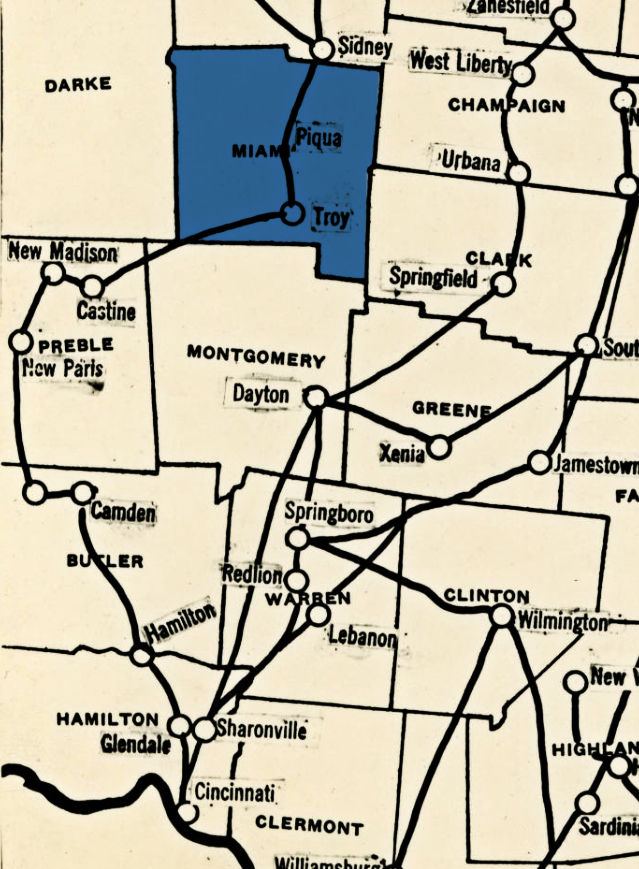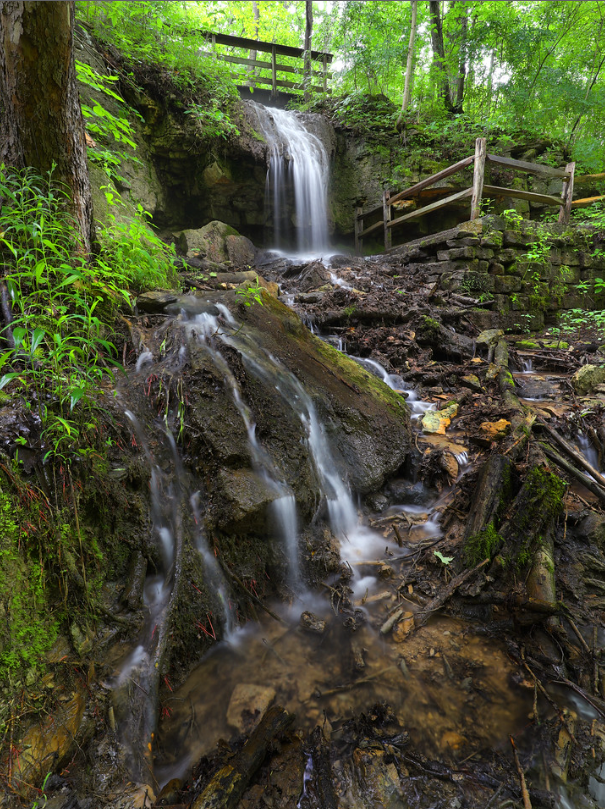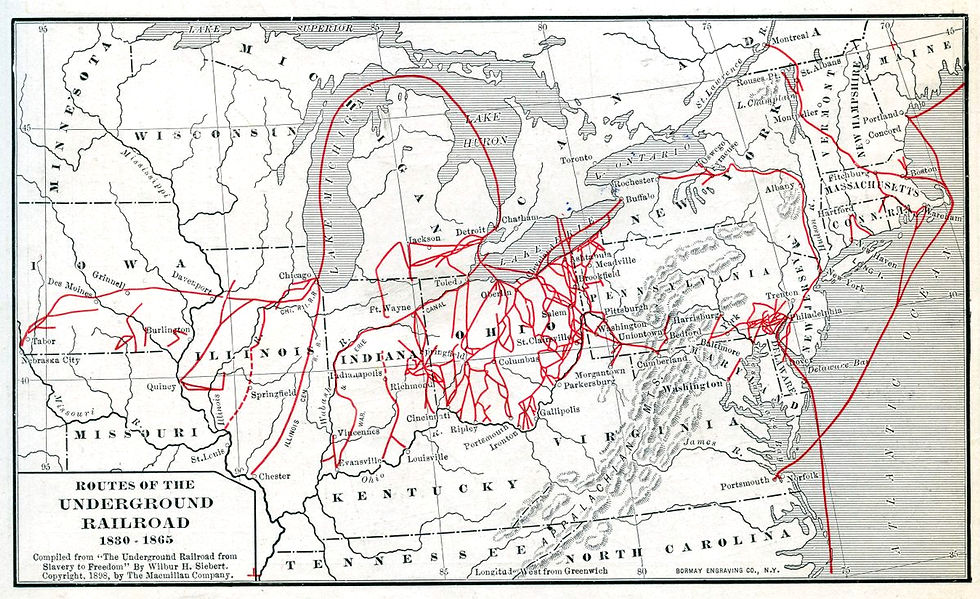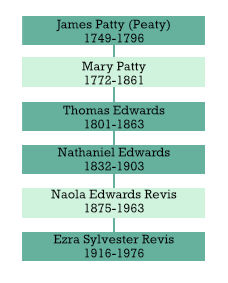
The Patty Boys
Quakers took the first public stand against slavery in 1688, beginning the abolitionist movement. In 1787 they organized and operated the Underground Railroad.
By 1850 it is estimated that over 50,000 slaves had escaped from the South using the Underground Railroad.
Our Grandmother Mary Patty Edwards came from a South Carolina Quaker family. Her brothers (and possibly her father) were a part of the Underground Railroad.
The Patty Family is registered with the Ohio Historical Society and the Underground Railroad Friends of Freedom Society. Their name shows in various documents as Patty, Peaty, or Paty.
This post focuses mainly on our 4x Great Grand Uncles—brothers of our 4x Great Grandmother Mary Patty Edwards--namely James Patty III and Charles Patty.

South Carolina Plantations
Jesse Patty, named on the map below, came to America with his brother James in 1764. King George III had granted land in Virginia to dissenters from the Church of England. The brothers later moved to South Carolina. Their plantations are all next to waterways. Jesse was on the Broad River. James Sr (James I) was on the Saluda River. James Jr (James II) was on the Tyger River.

Our Patty family was part of a Quaker community in Newberry County, South Carolina. Their Bush River Meeting of Friends was formed in 1772. One of the founding members was our 5x Great Grandfather David Mote, whose daughter Margaret married James Patty II. Margaret was the mother of our Mary Patty Edwards, James, Charles, and others.
In South Carolina
This map of the eastern United States shows UGRR routes from the South to freedom in the North. As you look at South Carolina, you can see that the trail goes right through the Quaker communities where the Patty family owned land.

The Friends in South Carolina had farms that were adversely impacted due to the heavy importation of slaves before the Congressional ban in 1808. Their lands became worth less and less. The Friends in Bush River began a migration to Ohio. They sold their lands, worth from ten to twenty dollars per acre, for from three to six dollars, and departed, never to return.
Between 1802 and 1807, the Bush River Meeting issued more than one hundred certificates of removal, most of them for families. This so depleted the membership that the monthly meeting seems to have been all but abandoned in 1808, though not formally laid down until 1822.

Move to Ohio
From: The Ohio and Indiana Pattys
By Albert Thomas Patty and J.C. Patty

The group from Bush River came to Ohio in one horse wagons. The 34 unit wagon-train was led by James Patty the younger and his brother David.
Charles Patty
While still in South Carolina, Charles’ (another of the brothers) wife Mary went to the wood for the cows and never returned. The cow bell kept ringing but going farther into the woods. When she did to return they thought the Indians were taking the cows further into the woods and had carried her off so gave up the search, but more than a year later her body was found in the Tyger river.
Charles later married Phoebe Pearson in 1805. They immediately made the trip to Ohio riding and walking. When they arrived they had less than one dollar between them. They built a cabin in a few days, the roof made of home made boards and puncheon for the floor. Straw was put in the corner for a bed. Utensils were a dutch oven, a long handled skillet, and an iron pot. Their first home was in Miami County north of Covington beside the Stillwater River.
The Indians causing them trouble in 1812, they removed to the south near Frederick (Fidelity). Here they saved enough to buy 320 acres of fine table land in Montgomery County 10 miles north of Dayton and east of the Stillwater River.
They cleared about 100 acres, the remainder being heavily wooded with hickory, sugar, poplar, etc. Large springs afforded water. The soil was suitable for growing all kids of fruit.
Here is their home which was a station on the Underground Railroad. They lived here 1832-1850. The book Miami County of Underground Railroad says that the house had hiding places for the UGRR (on page 16).

Detail of Miami County in eastern Ohio, showing Underground Railroad routes.

In 1806, James Patty, III and his family moved from their South Carolina plantation (Bush River Monthly Meeting) to the area serviced by the Friends’ Miami Monthly Meeting, held in Pleasant Hill, Ohio.

Pleasant Hill is about 7 miles west of Troy and 10 miles north of West Milton. The nearby Miami-Erie Canal opened before the civil war and was a route northward to Canada. His group of Quakers established the West Branch Friends Monthly Meeting on the Stillwater River. Families of that congregation were: Coppocks, Coates, Miles, Guys, Jays, Teagues, Hoovers, Motes, Fruases, and Cooks. The John Hoover who came at this time was the grandfather of President Herbert Hoover.

Located inside Englewood MetroPark is the picturesque Patty Falls, named after the James Patty family who settled nearby more than 150 years ago; it is an easily reached scenic spot.

James Patty moved on to Carroll County, Indiana in 1823.
West Milton Founding
Bush River Meeting members from South Carolina went on to found the village of West Milton, Ohio. It began in 1801 with Joseph and Rachel (McCool) Evans. His birth and that of his brothers and sisters is recorded in the Bush River Quaker Records in Newberry, S.C.

Location: 39.96421667, -84.32736667
West Milton Meeting House and Graveyard

In this 1920 map, you can see that Ohio was the state with the most UGRR activity. I wonder if this is partly because of the large Quaker migration to there from the South at the turn of the 19th century.
There is a Mote Cemetery in Miami County, Ohio; west of the village of West Milton. This could possibly be named after the Mote family from Bush River Meeting in Newberry, SC. We are descended from James Patty (1750-1796) and Margaret Mote (1753-1803) of the Bush River Meeting.

Sites:
Books:
The Ohio and Indiana Pattys by Albert Thomas Patty and J.C. Patty
Southern Quakers and Slavery
Troy, Piqua and Miami County, Ohio CentennialHistory
published 1909
The Annals of Newberry, SC by John Belton O’Neall
Newberry County, South Carolina: Historical and genealogical Annals" by George Leland Summer, 1980

![jan_koprek[1].jpg](https://static.wixstatic.com/media/5297dc_ceb3524c5f0d45e6af99f63eb2a32742~mv2.jpg/v1/fill/w_73,h_80,al_c,q_80,usm_0.66_1.00_0.01,enc_avif,quality_auto/jan_koprek%5B1%5D.jpg)
Comments